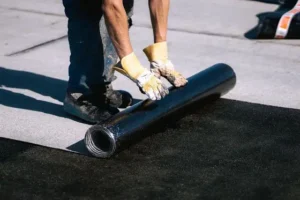Waterproof membranes play a critical role in protecting buildings, structures, and surfaces from water damage. Whether it’s the roof of a house, the foundation of a building, or the floors of a wet room, these membranes act as barriers that prevent water from penetrating and causing damage. But how long should a waterproof membrane last? The answer is not as straightforward as you might think. It depends on various factors such as the type of membrane, installation quality, environmental conditions, and maintenance practices.
In this blog post, we’ll explore how long different types of waterproof membranes can last and what factors influence their longevity.
1. Types of Waterproof Membranes
Before diving into their lifespan, it’s essential to understand the types of waterproof membranes available. Generally, membranes can be categorized into two main types: sheet membranes and liquid-applied membranes. Each type has its own expected lifespan.
Sheet Membranes:
Sheet membranes are pre-formed, factory-produced sheets that are installed on surfaces. They are typically made from materials such as:
-
Bituminous (Asphalt-Based) Membranes: These are some of the oldest and most commonly used waterproofing systems. They are usually reinforced with polyester or fiberglass to improve durability.
-
PVC (Polyvinyl Chloride) Membranes: Flexible, durable, and resistant to a wide range of weather conditions, these membranes are common in commercial waterproofing applications.
-
EPDM (Ethylene Propylene Diene Monomer) Membranes: These synthetic rubber membranes are highly durable and have excellent resistance to UV rays, ozone, and extreme temperatures.
Liquid-Applied Membranes:
These membranes are applied as a liquid and then cure to form a seamless, flexible coating. They are popular for both residential and commercial applications and include:
-
Polyurethane Membranes: These are durable, elastic, and provide excellent protection against water ingress. They are ideal for horizontal and vertical surfaces.
-
Acrylic Membranes: These are less durable than polyurethane but still offer reasonable protection, especially for applications that aren’t subject to extreme environmental stress.
2. Expected Lifespan of Waterproof Membranes
The lifespan of a waterproof membrane depends on several factors, including material type, environmental exposure, and maintenance. Below is an estimated range of lifespans for different types of membranes.
Bituminous Membranes:
-
Lifespan: 15–20 years
-
Factors Affecting Longevity: Bituminous membranes are relatively affordable but are prone to degradation from UV exposure. With proper maintenance, such as regular inspections and repairs, they can last closer to the 20-year mark. However, their performance in extreme weather conditions might be less reliable.
PVC Membranes:
-
Lifespan: 20–30 years
-
Factors Affecting Longevity: PVC membranes are known for their resistance to UV rays and weathering. They are particularly good in areas with hot climates or high UV exposure. Regular maintenance can ensure that they last on the higher end of the spectrum.
EPDM Membranes:
-
Lifespan: 25–50 years
-
Factors Affecting Longevity: EPDM membranes are highly durable and UV-resistant, which is why they are often used in commercial buildings and large projects. With proper care, they can last up to 50 years, making them one of the longest-lasting options.
Polyurethane Membranes:
-
Lifespan: 10–20 years
-
Factors Affecting Longevity: Polyurethane membranes are highly resistant to water but can degrade over time due to UV exposure, mechanical wear, or extreme weather. While they are flexible and ideal for applications that require movement, their lifespan is shorter compared to other materials unless they are regularly maintained.
Acrylic Membranes:
-
Lifespan: 10–15 years
-
Factors Affecting Longevity: Acrylic membranes are less durable than other options, mainly due to their vulnerability to UV damage and wear. They are better suited for low-traffic areas and less demanding environments.
3. Factors That Affect the Longevity of Waterproof Membranes
The lifespan of a waterproof membrane doesn’t only depend on the material itself. Several external factors can significantly influence how long it lasts. Here are the main ones to keep in mind:
1. Quality of Installation
No matter how durable the material is, improper installation can drastically reduce the lifespan of a waterproof membrane. Incorrect bonding, poor seam welding, or inadequate surface preparation can lead to leaks and early deterioration. It’s essential to hire professional installers who follow manufacturer guidelines to ensure a long-lasting result.
2. Environmental Conditions
Waterproof membranes are exposed to the elements, and environmental conditions play a major role in their longevity. For instance:
-
UV Exposure: Prolonged exposure to sunlight can break down certain materials, especially bituminous and polyurethane membranes.
-
Temperature Extremes: Extreme cold or heat can cause materials to become brittle or expand and contract, leading to cracks or tears in the membrane.
-
Moisture and Chemicals: Continuous exposure to moisture or harsh chemicals can also accelerate degradation, particularly in industrial or marine environments.
3. Maintenance and Inspections
Routine inspections and maintenance are key to extending the lifespan of a waterproof membrane. Regular checks for signs of damage—such as punctures, cracks, or blisters—should be performed. Re-sealing joints, repairing minor damages, and keeping the surface clean can help prevent water ingress and reduce the need for costly repairs or replacements.
4. Traffic and Wear
If the membrane is subjected to heavy foot or vehicle traffic, it may degrade faster. Some membranes are designed to withstand heavy use (e.g., on parking decks or pedestrian walkways), but others are more suited to low-traffic areas. It’s essential to ensure that the membrane is appropriate for the intended use.
4. How to Extend the Lifespan of Your Waterproof Membrane
If you want to maximize the lifespan of your waterproof membrane, here are a few tips:
-
Regular Inspections: Check for cracks, punctures, and signs of wear at least once a year, or more frequently in harsh weather conditions.
-
Clean the Surface: Keep the membrane clean and free from debris, as dirt and moss can cause premature wear.
-
Seal and Repair: Small cracks and holes should be repaired immediately to prevent water ingress from spreading.
-
Avoid Heavy Traffic: Limit foot or vehicle traffic on the membrane, especially if it’s not designed for such use.
5. When Should You Replace Your Waterproof Membrane?
While waterproof membranes can last for decades, they do not last forever. Here are some signs it’s time to replace your membrane:
-
Visible Cracking or Peeling: If the membrane has visible signs of deterioration, such as cracking or peeling, it may no longer provide effective waterproofing.
-
Frequent Leaks: If leaks become more frequent, even after repairs, it’s likely the membrane has reached the end of its lifespan.
-
Pooling Water: If water begins to pool on the surface and doesn’t drain, it could indicate that the membrane has lost its integrity.
Conclusion
The lifespan of a waterproof membrane can vary significantly depending on its material, installation, and maintenance. In general, you can expect most membranes to last between 10 and 50 years, with high-quality materials like EPDM membranes offering the longest protection. Regular maintenance and timely repairs are essential to ensure your waterproofing system remains effective for as long as possible.
If you’re unsure about the condition of your membrane or need advice on the best type for your project, consulting with a professional can help you make an informed decision.






